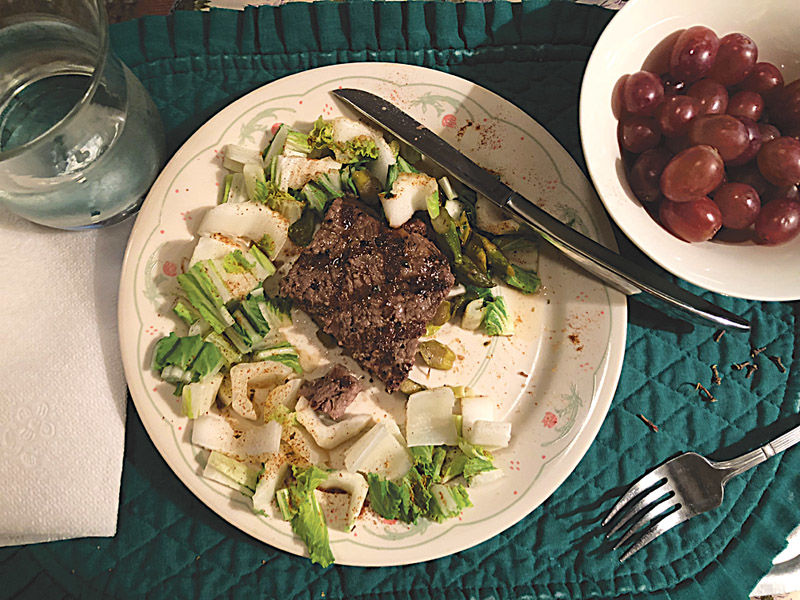The ‘No’ Diet is really saying ‘Yes’ to wonderful things that bring life
Published 7:00 am Wednesday, October 9, 2019

- Rethink mealtime — experiment often. Don’t give up favorites and find new ones — add water, often.
Sometimes life gives you lemons, but oh, the sweetness of turning it into lemonade — or lemon bars, lemon cake or any number of delicious things. The word “diet” is a four-letter word that looks, smells and feels like a bad word. The truth is, diet is not a bad word. It’s what we eat — short for dietary. For specific guidelines, search “Dietary Guidelines for Americans” online.
The human diet can vary widely. In nutrition, diet is the sum of food consumed by a person or other organism. The word diet often implies the use of specific intake of nutrition for health or weight-management reasons, with the two often being related. Although people are omnivores, each culture and each person holds some food preferences or some food taboos. This may be due to personal tastes or ethical reasons. Individual dietary choices may be more or less healthy.
Trending
Complete nutrition requires ingestion and absorption of vitamins, minerals, essential amino acids from protein and essential fatty acids from fat-containing food, also food energy in the form of carbohydrate, protein and fat. Dietary habits and choices play a significant role in the quality of life, health and longevity.
Knowing the right “formula” diet for your body’s best performance is totally unique and takes time, paying attention and willingness to say “YES,” rather than hearing, “NO” this or that. Yes to delicious, fresh fruits, healthy vegetables, starch alternatives, new spices, trying new dishes, yes to using lemons and — the best for me, personally, capers go great with lemons.
Starting with the basics, from recent personal experience, I know that most of us do not realize the importance of water for a healthy life. The body can become easily dehydrated as mine did this past week, and in a way that could have become life threatening. I needed to do some research. Here is what I found.
Why do we need to drink water?
Your body uses water in all its cells, organs, and tissues to help regulate its temperature and maintain other bodily functions. Because your body loses water through breathing, sweating, and digestion, it’s important to rehydrate by drinking fluids and eating foods that contain water. — EverydayHealth.com
What are three reasons why water is important?
Trending
Bodies need water to replenish the lost fluid from sweat. Everyone needs enough water in their system to have healthy stool and avoid constipation. Kidneys are also important for filtering out waste through urination. Adequate water intake helps kidneys work more efficiently and helps to prevent kidney stones. It’s common to hear that water is essential for your health. But why? This substance makes up a majority of body weight and is involved in many important functions including flushing out waste from the body, regulating body temperature and helping brain function. We get most of the needed water from drinking beverages, but food also contributes a small amount for daily water intake.
Drinking water helps create saliva, regulates body temperature, protects tissues, spinal cord and joints, helps excrete waste through perspiration, urination and defecation. Drinking water helps maximize physical performance, prevents constipation, aids in digestion, helps with nutrient absorption and helps with weight loss. Water improves blood oxygen circulation, helps fight off illness, helps boost energy and aids in cognitive function. Water helps improve mood, keeps skin bright and prevents overall dehydration. — Healthline.com
Why is hydration important?
Dehydration is the result of the body not having enough water. And because water is imperative to so many bodily functions, dehydration can be very dangerous.
Severe dehydration can result in a number of severe complications, including swelling in the brain, kidney failure and seizures. Make sure to drink enough water to make up for what’s lost through sweat, urination and bowel movements to avoid dehydration. — Healthline.com
How much water should people drink?
Being attentive to the amount of water you drink each day is important for optimal health. Most people drink when they’re thirsty, which helps regulate daily water intake. According to the National Academies of Sciences, Engineering, and Medicine, general water intake, from all beverages and foods, that meet most people’s needs are about 15.5 cups of water (125 ounces) each day for men and about 11.5 cups (91 ounces) daily for women. People get about 20 percent of their daily water intake from food. The rest is dependent on drinking water and water-based beverages. So, ideally men would consume about 100 ounces (3.0 liters) of water from beverages, and women, about 73 ounces (2.12 liters) from beverages. Increase your water intake if exercising or living in a hotter region to avoid dehydration. Other ways to assess hydration include thirst and the color of urine. Feeling thirsty indicates your body is not receiving adequate hydration. Urine that is dark or colored indicates dehydration. Pale or non-colored urine typically indicates proper hydration. — Healthline.com
What are some alternatives to drinking water for hydration?
START THE DAY WITH OATMEAL. This one is a classic. Not only is it hearty and filling, oatmeal is also very hydrating. When oats are cooking, they expand and absorb the water or milk they’re being paired with. Not into warm breakfasts when it’s hot out? Try overnight oats. Served cold, overnight oats pack all the benefits of hot oatmeal with no heat. As an added boost, sprinkle chia seeds in your overnight oats when preparing, which soak up 10 times their weight in extra liquid and keep you full all morning.
INCLUDE MORE MOO. According to a study by McMaster University, milk is more hydrating than water or sports drinks due to its source of protein, carbohydrates, calcium, and electrolytes. Bring it on!
TRY CARB ALTERNATIVES. When it comes to meal planning, ditch dry, carb heavy staples like pasta. Opt for zucchini noodles, or zoodles for short, which can contain about 95 percent water. When paired with a tomato sauce, which usually has about 90 percent water, this meal can pack a hydrating and healthy punch.
SIP SMOOTHIES. Between the yogurt and all the fresh fruit, smoothies are a great and tasty way to stay hydrated. Not sure what fruits and vegetables to pick? Strawberries, peaches, cucumbers, spinach and blueberries are all excellent options.
PACK THE PLATE WITH VEGETABLES. Much like smoothies, salads are a great way to give you a hydrating boost. Most lettuce greens contain at least 94 percent water, and that’s before you add any other vegetables. Next time you whip up a salad, include celery, tomatoes, bell peppers and carrots.
SLURP SOUP. When the craving strikes for a filling and hydrating meal, look no further than broth-based soups or gazpacho. Served cold, gazpacho won’t make you break a sweat come summer. Blend cucumbers, bell peppers, tomatoes, onions and garlic cloves for this satisfying soup.
FREEZE YOUR FRUIT. Feeling nostalgic about the popsicles you used to enjoy as a child? Bring back this classic treat as a delicious way to rehydrate. Blend a hydrating ingredient like watermelon and fill Popsicle molds and freeze for 1 hour. — MedExpress.com
Why are older adults at higher risk for dehydration?
Unfortunately, the body’s mechanisms meant to protect us from dehydration work less well as we age. Older adults have reduced thirst signals and also become less able to concentrate their urine. Other factors that put older adults at risk include the following.
CHRONIC PROBLEMS with urinary continence, which can make older adults reluctant to drink a lot of fluids.
MEMORY PROBLEMS can cause older adults to forget to drink often, or forget to ask others for something to drink.
MOBILITY PROBLEMS can make it harder for older adults to get something to drink
LIVING IN NURSING HOMES because access to fluids often depends on the availability and attentiveness of staff.
SWALLOWING DIFFICULTIES Dehydration can be brought on by an acute illness or other event. Vomiting, diarrhea, fever and infection are all problems that can cause people to lose a lot of fluids and become dehydrated. And of course, hot weather always increases the risk of dehydration.
Last but not least, older adults are more likely to be taking medications that increase the risk of dehydration, such as diuretic medications, which are often prescribed to treat high blood pressure or heart failure.
A UK study of older adults in residential care found that 46 percent had impending or current dehydration, as diagnosed by blood tests. — BetterHealthWhileAging.com.
TILAPIA WITH LEMON CAPERS
4 6-ounce tilapia fillets, or
favorite fish
1/2 teaspoon salt
1/4 teaspoon pepper
1 Tablespoon all-purpose flour
1 Tablespoon olive oil
1/2 cup reduced-sodium
chicken broth
2 Tablespoons lemon juice
1 Tablespoon butter
1 Tablespoon drained capers
Lemon wedges, optional
Hot cooked pasta, optional
Sprinkle tilapia with salt and pepper. Dust lightly with flour. In a large skillet, heat oil over medium heat. Add tilapia; cook until lightly browned and fish just begins to flake easily with a fork, 3-5 minutes per side. Remove from pan; keep warm. Add broth, lemon juice, butter and capers to same skillet; cook and stir until mixture is reduced by half, about 5 minutes. Spoon over tilapia. If desired, serve with pasta and lemon wedges.
Catherine Jensen, Blytheville, Arkansas, TasteofHome.com
LEMON-DIJON PORK SHEET-PAN SUPPER
4 teaspoons Dijon mustard
2 teaspoons grated lemon zest
1 garlic clove, minced
1/2 teaspoon salt
2 Tablespoons canola oil
1 1/2 pounds sweet potatoes (about 3 medium), cut into 1/2-inch cubes
1 pound fresh Brussels sprouts (about 4 cups), quartered
4 6-ounce boneless pork loin chops
Ground pepper, optional
Preheat oven to 425 degrees. In a large bowl, mix first 4 ingredients; gradually whisk in oil. Remove 1 tablespoon mixture for brushing pork. Add vegetables to remaining mixture; toss to coat. Place pork chops and vegetables in a 15x10x1-in. pan coated with cooking spray. Brush chops with reserved mustard mixture. Roast 10 minutes. Turn chops and stir vegetables; roast until a thermometer inserted in pork reads 145° and vegetables are tender, 10-15 minutes longer. If desired, sprinkle with pepper. Let stand 5 minutes before serving.
Elisabeth Larsen, Pleasant Grove, Utah, TasteofHome.com
LEMONY CHICKPEAS
2 cups uncooked instant brown rice
1 Tablespoon olive oil
1 medium onion, chopped
2 15-ounce cans chickpeas, rinsed and drained
1 14-ounce can diced tomatoes, undrained
1 cup vegetable broth
1/4 teaspoon crushed red
pepper flakes
1/4 teaspoon pepper
1/2 teaspoon grated lemon zest
3 Tablespoons lemon juice
Cook rice according to package directions. Meanwhile, in a large skillet, heat oil over medium heat. Add onion; cook and stir 3-4 minutes or until tender. Stir in chickpeas, tomatoes, broth, pepper flakes and pepper; bring to a boil. Reduce heat; simmer, covered, 10 minutes to allow flavors to blend. Uncover; simmer 4-5 minutes or until liquid is slightly reduced, stirring occasionally. Stir in lemon zest and lemon juice. Serve with rice. Freeze option: Do not prepare rice until later. Freeze cooled chickpea mixture in freezer containers. To use, partially thaw in refrigerator overnight. Heat through in a saucepan, stirring occasionally and adding a little broth if necessary. Serve with rice.
April Strevell, Red Bank, New Jersey, TasteofHome.com
LEMON-OLIVE CHICKEN WITH ORZO
1 Tablespoon olive oil
4 boneless skinless chicken thighs (about 1 pound)
1 14.5-ounce can reduced-
sodium chicken broth
2/3 cup uncooked whole wheat orzo pasta
1/2 medium lemon, cut 4 wedges
1/2 cup pitted Greek olives, sliced
1 Tablespoon lemon juice
1 teaspoon dried oregano
1/4 teaspoon pepper
In a large nonstick skillet, heat oil over medium heat. Brown chicken on both sides; remove from pan. Add broth to skillet; increase heat to medium-high. Cook 1-2 minutes, stirring to loosen browned bits from pan. Stir in remaining ingredients; bring to a boil. Reduce heat; simmer, uncovered, 5 minutes, stirring occasionally. Return chicken to pan. Cook, covered, 5-8 minutes or until pasta is tender and a thermometer inserted in chicken reads 170°.
NOTE: This quick skillet recipe is a healthy all-in-one meal. I just add a tossed salad for a menu the entire family loves.
Nancy Brown, Dahinda, Illinois, TasteofHome.com




